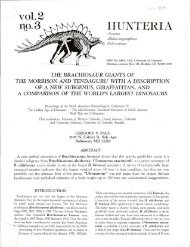THE MANY MYTHS, SOME OLD, SOME NEW, OF ... - Gregory S. Paul
THE MANY MYTHS, SOME OLD, SOME NEW, OF ... - Gregory S. Paul
THE MANY MYTHS, SOME OLD, SOME NEW, OF ... - Gregory S. Paul
Create successful ePaper yourself
Turn your PDF publications into a flip-book with our unique Google optimized e-Paper software.
70 G. S. PAUL<br />
Reality: It is now widely agreed that the world's many trackways prove that all types<br />
of dinosaurs usually carried their tails well clear of the ground, in accord with the<br />
upwards arch seen in the base of many, but not all, dinosaurs. With rare exceptions,<br />
there is no reason except inertia for restoring tail dragging dinosaurs.<br />
Other anatomical points that have been recognized, either recently or well in the<br />
past, include the posterior sweep of the anterior dorsal ribs, the placement of the<br />
coracoids close to the body midline, and the digitigrade foot posture true of all<br />
dinosaurs (<strong>Paul</strong>, 1987a; Carpenter, 1989). Yet many dinosaurs are restored with<br />
vertical chest ribs, overly broad shoulder girdles, and sauropod hindfeet and even<br />
forefeet are often mounted as being plantigrade (the astragalus of sauropods has<br />
rotated posteriorly from the prosauropod condition, rather than anteriorly as argued<br />
by Cooper, 1984).<br />
MODERATELY SHORT ARMS, SUPPLE HANDS AND HINDPRINT ONLY<br />
TRACKWAYS SHOW THAT <strong>MANY</strong> DINOSAURS WERE BIPEDAL, OR<br />
SLOW<br />
Myth: Ornithopod trackways made up only of hindprints are usually taken as proof<br />
of bipedalism. The arms of large ornithopods, and the supple hands of heterodontosaurs,<br />
have been viewed as unsuitable for a fast quadrupedal gait. Because the arms<br />
of large ornithopods and ceratopsids supposedly lagged behind the longer legs, they<br />
would have caused the subjects to either nose dive, or to spin around at high speeds<br />
(Thulborn, 1989; and in part Bakker, 1986).<br />
Reality: 'Quadrupedal elephants usually leave only their hindprints behind, the<br />
foreprints are wiped out by the forefeet. The arms of large ornithopods, especially<br />
hadrosaurs, were ungulate-like and suitable for progression at all speeds, and it is<br />
possible that many seemingly bipedal trackways were made by individuals on all<br />
fours (Figure 1). Some terrestrial primates, such as baboons and patas monkeys, trot<br />
and gallop on supple fingered hands, so it is possible that long fingered heterodontosaurs<br />
did the same. As long as all the limbs are long enough to easily reach the ground<br />
when the body is horizontal, then the stride lengths of limbs of differing length are<br />
equalized by increasing the recovery/step phase ratio of the shorter limb-this<br />
occurs in quadruped ally running long armed giraffe, gnu and hyenas, and short<br />
armed dik-diks, cats, crocs and lizards. In addition, scapular rotation probably<br />
increased the functional length of dinosaur forelimbs (<strong>Paul</strong>, 1987a).<br />
<strong>THE</strong> FORELIMBS <strong>OF</strong> QUADRUPEDAL DINOSAURS<br />
WERE NOT FULLY ERECT<br />
Myth: New skeletal mounts continue to be equipped with wide space forelimbs, and<br />
a few workers continue to favor such a limb posture, especially in ceratopsids and<br />
ankylosaurs (Coombs, 1978b; Johnson, 1990; Lehman, 1989).<br />
Reality: Almost all quadrupedal dinosaur trackways, including those of ceratopsids<br />
and ankylosaurs, show the forefeet following a narrow gauge that is either the same<br />
or a little broader than that of the hindlimbs. The orientation of quadrupedal<br />
handprints shows that the elbow was tucked in. The design and orientation of the<br />
shoulder glenoids of quadrupedal dinosaurs is very different from those of reptiles<br />
with sprawling limbs, and clearly favors a more vertical action. Stress analyses of<br />
dinosaur humeri and detailed joint articulation diagrams indicate a vertical arm









